< English version below>
Ha causado un gran revuelo la datación de tres muestras de arte rupestre que indica que sus autores eran neandertales. Son las cuevas La Pasiega, Maltravieso y Ardales (España). Sin duda, es un dato muy importante. Pero, ¿nos debe sorprender tanto? Todavía son recientes otras publicaciones en los últimos años que evidencian la capacidad cognitiva de los neandertales. En este post he querido enumerar algunos ejemplos, agrupándolos en cinco tipologías:
1) Estructuras: cueva de Bruniquel (Francia), 176 ka
En 2016 se publicaron varias estructuras circulares realizadas con 400 fragmentos de estalagmitas a 330 metros de la entrada a la cueva. Los materiales se trocearon hasta tener un tamaño similar y se dispusieron formando un círculo grande por un parte, otro círculo más pequeño por otra, y pequeños amontonamientos. A este hallazgo acompaña la presencia de restos de hogueras, que evidencian el fuego que tuvieron que emplear para fabricar los pilares y disponerlos en un orden concreto en lo más profundo de la cueva.
Aquellos humanos concibieron y construyeron esta construcción a partir de 2 toneladas de estalagmitas, y tendrían una cierta organización social para preparar el trabajo y los materiales, transportarlos y finalmente ordenarlos.
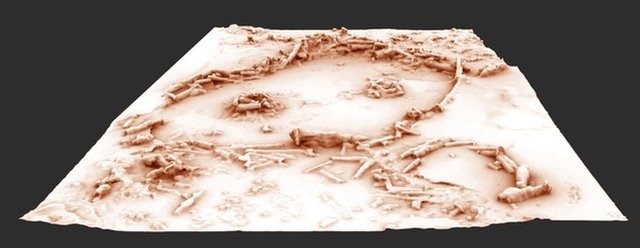
3D reconstruction of the stalagmite structures in the Bruniquel Cave in France. Credit: Xavier MUTH – Get in Situ, Archéotransfert, Archéovision -SHS-3D, base photographique Pascal Mora
2) Adornos: brazalete o collar hecho con garras de águila en Krapina (Croacia), 130 ka.
Hace un siglo se encontraron en Krapina numerosos restos humanos, cientos de útiles líticos y restos de fauna, entre los que se hallaban 8 garras de águila de cola blanca (Haliaëtus albicilla) y una falange. Estas se reestudiaron en 2014, y se descubrió que fueron trabajadas y pulidas para conformar un adorno con uso de brazalete o collar. Tradicionalmente, este tipo de ornamentos se habían asociado únicamente al desarrollo de capacidades cognitivas y simbólicas propias de los humanos modernos.
En este grupo incluyo también:
- Las evidencias del procesamiento de plumas de rapaces y córvidos en tres cuevas de Gibraltar para un probable uso ornamental.
- Las conchas perforadas y pigmentos rojos y amarillos en Cueva de los Aviones (115-120 ka) y Cueva Antón (50 ka), ambas en Murcia (España), y en Cueva Fumane (45-47 ka) en Italia.
3) Pinturas rupestres: tres cuevas en España, 64-66 ka.
Se trata de los tres paneles pictóricos con los que he abierto este post:
- Cueva de La Pasiega (Cantabria). Un signo escaleriforme de 64 ka.
- Cueva de Maltravieso (Cáceres). Huella de una mano casi completamente cubierta de calcita. 66 ka.
- Cueva de Ardales (Málaga). Una columna con manchas de pigmento rojo, algunas de 65 ka y otras de 45 ka.
Pero además destaco otros dos ejemplos:
- El Castillo (España): una serie de 90 discos rojos datados en 40,8 ka en 2012, y varias siluetas de manos de 37,3 ka.
- Cueva de Nerja (España): en 2012 se publicó la datación de 42 ka para los restos de carbón recuperados a 10 cm de un conjunto de 6 focas pintadas sobre estalactitas en la cueva de Nerja. La hipótesis que manejan los investigadores es que fueron restos de antorchas usadas para iluminar las pinturas a la hora de hacerlas o posteriormente observarlas. Sin embargo, para que esa hipótesis gane aceptación, el análisis debe completarse con la datación pendiente de la costra de calcita existente sobre el propio pigmento.
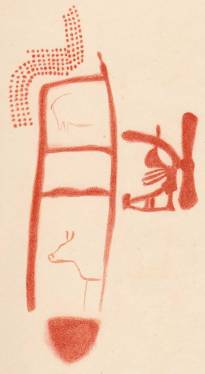
Dibujo de las pinturas de La Pasiega realizado por el prehistoriador francés Henri Breuil en 1913. Las siluetas animales son posteriores.
4) Enterramientos rituales: Des-Cubierta (España), 40-45 ka.
Los enterramientos neandertales con signos rituales son numerosos y merecen un post aparte: La Chapelle-aux-saints, Tabun, Kebara, Shanidar, La Ferrasie… Aquí voy a destacar el último que se publicado (2016), en la cueva Des-Cubierta en Pinilla del Valle (España), de unos 40-45 ka.
Consiste en unos restos humanos de una niña neandertal (fragmento de mandíbula y 6 dientes), hallados en asociación a un conjunto de 30 cuernos de herbívoros (uro, bisonte, ciervo) y un cráneo de rinoceronte colocados ordenadamente de forma que recuerdan a trofeos de caza modernos. La falta de evidencias de procesamiento de fauna, y la particular disposición que requiere una elaborada construcción y asociación de objetos de forma arbitraria, hacen sugerir que sea un enterramiento ritual.
Un nuevo estudio de 2023 refuerza el carácter simbólico de la acumulación de los 35 cráneos con apéndices hallados en el nivel 3 de Des-Cubierta, pero los separa de la posible vinculación con la mandíbula infantil del nivel 2.
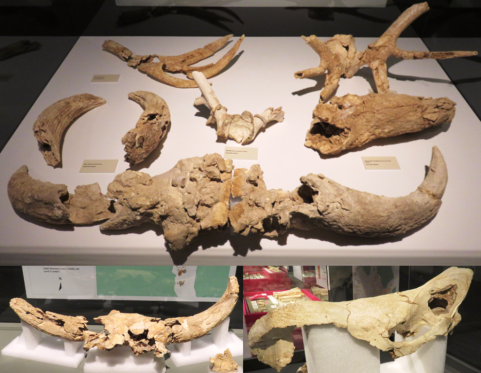
Restos de uro, bisonte, ciervo y rinoceronte. Cueva Des-Cubierta, Pinilla del Valle. Crédito foto: Roberto Sáez
5) Grabados: signos en Gorham’s Cave (Gibraltar, UK), 39 ka.
Un conjunto de signos entrecruzados grabados laboriosamente durante varias horas de trabajo (se estiman más de 300 trazos), descubiertos en 2012. Su dimensión es 20 x 20 cm, se encuentra en un nivel inferior al de un conjunto de útiles Musterienses y su datación es de al menos 39 ka.
Conclusión
Creo que la nueva publicación de las pinturas se ha interpretado como un punto de ruptura en la asociación exclusiva al humano moderno de una capacidad de cognición avanzada. O al menos así lo percibe el público general a partir de la información difundida en la prensa no especializada. Celebro que esta investigación esté sirviendo para borrar un poco más la imagen todavía negativa de los neandertales como humanos arcaicos y estúpidos. Nadie negará que lamentablemente esta imagen está todavía en la cabeza de bastante gente.
Imaginemos que, partiendo de cero, tuviéramos que caracterizar a una nueva especie Homo neanderthalensis a partir de las evidencias de sus obras. Tendríamos el simbolismo que evidencian algunas pinturas, la autoconciencia que manifiestan los adornos y los enterramientos, la abstracción y planificación reflejadas en la creación de estructuras, la fabricación de la industria lítica Musteriense o el uso de pegamento natural para la preparación de lanzas… Y todo ello, unido al éxito que tuvieron como especie a lo largo de 300.000 años (o más), superando glaciaciones y el aislamiento y extinción de algunos grupos, mientras otros conseguían sobrevivir y expandirse por Eurasia… ¿No los caracterizaríamos como unos humanos con una capacidad cognitiva muy próxima a la nuestra?
Pero tampoco nos pasemos al extremo opuesto. No podemos todavía generalizar a toda la especie Homo neanderthalensis el desarrollo cognitivo que observamos en algunos grupos concretos, ni tampoco podemos asumir que ese desarrollo fue homogéneo en todo el periodo de tiempo en que vivieron.
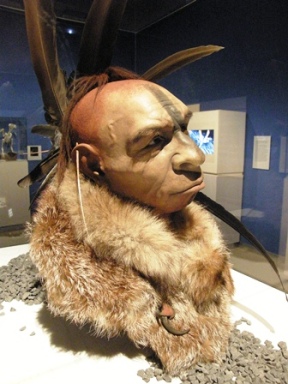
Neandertal: escultura del paleoartista Fabio Fogliazza. Museo de la Evolución Humana (Burgos, España). Crédito foto: Roberto Sáez
5 cases of neandertal symbolism
Recently we had a great noise in the media, because of the dating of some rock art samples which fall within the neandertal period of three caves in Spain: La Pasiega, Maltravieso and Ardales. That is certainly very important. But should it surprise us so much? We still have other recent publications in the last few years that show a cognitive ability of neandertals. In this post I wanted to list some examples, grouping them into five typologies:
1) Structures: Bruniquel cave (France), 176 ka
Since 2016 we know a set of ring structures made of 400 stalagmites fragments deep in the cave, 330 meters from its entrance. They were cut to a similar size and arranged into a large circle on one side, a smaller circle on the other, and small piles. There are also fire remains, which evidence the light that had to be used to manufacture the pillars and arrange them in such certain order at the deepest part of the cave.
Those humans conceived and built this construction with 2 tons of stalagmites, and they would have a certain social organization to prepare the work and materials, transport them and finally order them.
2) Ornaments: bracelet or necklace made with eagle claws in Krapina (Croatia), 130 ka.
A century ago many human remains, hundreds of stone tools and fauna remains were found in Krapina, including 8 white-tailed eagle claws (Haliaëtus albicilla) and one phalanx. These were re-studied in 2014, and it was found that they were worked and polished to form an ornament with the use of a bracelet or necklace. Traditionally, such ornaments had been associated only with the development of cognitive and symbolic capacities of modern humans.
In this group I also include:
- Evidence of raptor and corvid processing to obtain feathers for a probable ornamental use, in three Gibraltar caves.
- Perforated shells and red and yellow pigments in Cueva de los Aviones (115-120 ka) and Cueva Antón (50 ka), both in Murcia (Spain), and Cueva Fumane (45-47 ka) in Italy.
3) Cave paintings: at least three caves in Spain, 64-66 ka.
These are the three rock art panels mentioned at the beginning of this post:
- La Pasiega Cave (Cantabria). A scaleriform sign of 64 ka.
- Cave of Maltravieso (Cáceres). Handprint almost completely covered in calcite. 66 ka.
- Ardales Cave (Málaga). A column with red pigment spots, some dated at 65 ka and others at 45 ka.
But I also highlight two other examples:
- El Castillo cave (Spain): a series of 90 red dots were dated at 40.8 ka in 2012, as well as several handprints at 37.3 ka.
- Nerja cave (Spain): a study in 2012 estimated 42 ka for the charcoal remains found at 10 cm from a set of 6 seals painted on stalactites in the Nerja cave. The hypothesis argued by the researchers is that the charcoal was a product of torches used to illuminate the paintings when they are made or later observed. However, this hypothesis must gain acceptance by dating the existing calcite crust on the pigment itself.
4) Ritual burials: Des-Cubierta (Spain), 40-45 ka.
The neandertal burials with ritual signs are numerous and deserve a separate post: La Chapelle-aux-saints, Tabun, Kebara, Shanidar, La Ferrasie… Here I highlight the last one published (2016), in the Des-Cubierta cave in Pinilla del Valle (Spain), dated at 40-45 ka.
It consists of human remains of a neandertal girl (fragment of jaw and 6 teeth), found in association with a set of 30 horns of herbivores (aurochs, bison, deer) and rhino skull giving them the appearance of a modern hunting trophy. The lack of evidence for fauna processing and the disposition of remains requiring an elaborate and consistent series of associations with arbitrary objects, suggest that it is a ritual burial.
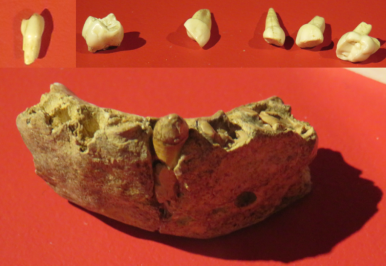
Neandertal mandible and teeth from Cueva Des-Cubierta, Pinilla del Valle. Photo credit: Roberto Sáez
5) Engravings: signs in Gorham’s Cave (Gibraltar, UK), 39 ka.
A deeply impressed cross-hatching laboriously carved into the bedrock during several hours of work (probably more than 300 strokes), discovered in 2012. Its dimension is 20 x 20 cm and it has remained covered by an undisturbed archaeological level containing Mousterian artifacts made by neandertals at least 39 ka.
Conclusion
I believe that the recent publication of the rock art has been interpreted as a breakthrough in the exclusive association of advanced cognition capabilities to modern human. This is likely to be the case among the general public, based on information in the non-scientific press. I am pleased that this research is further erasing the still negative image of neandertals as archaic and stupid humans. No one will deny that unfortunately this image is still in the minds of many people.
Let’s imagine that, starting from scratch, we would have to characterize a new Homo neanderthalensis species from the evidences of their works. We would have the symbolism evidenced by some paintings, the self-consciousness shown by ornaments and burials, the abstraction and planning reflected in the creation of structures, the manufacture of the Mousterian industry or the use of natural glue for the preparation of spears… And all this, together with the success they had as a species throughout 300,000 years (or more), overcoming glaciations and the isolation and extinction of some groups, while others managed to survive and expand through Eurasia… Wouldn’t we characterize them as humans quite close to our cognition?
But let’s not move from end to end. We may not yet generalize the cognitive development that we observe in some specific groups to the entire Homo neanderthalensis species, nor can we assume that this development was homogeneous throughout the period of time in which they lived.

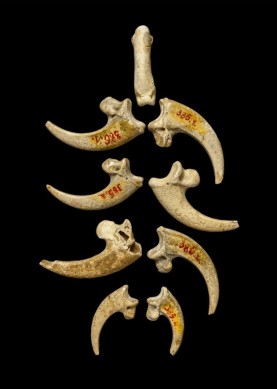

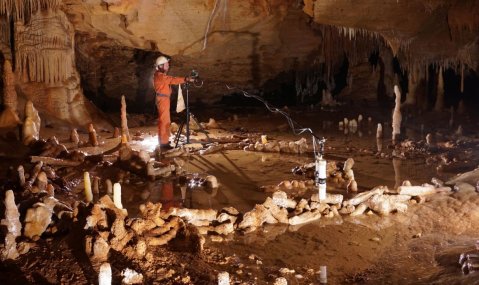
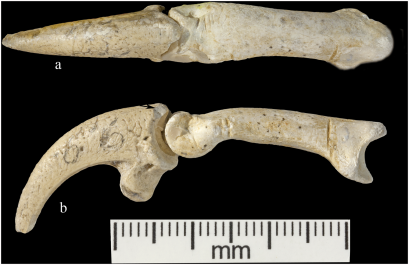
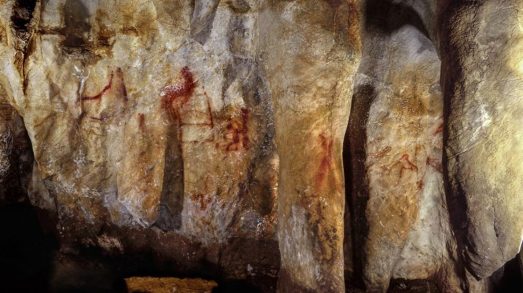
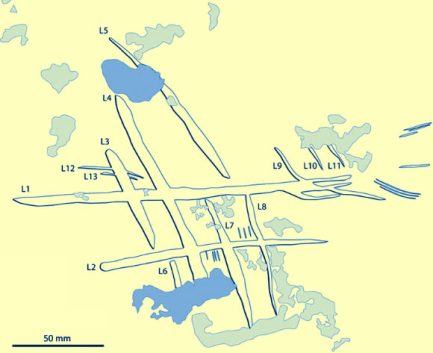
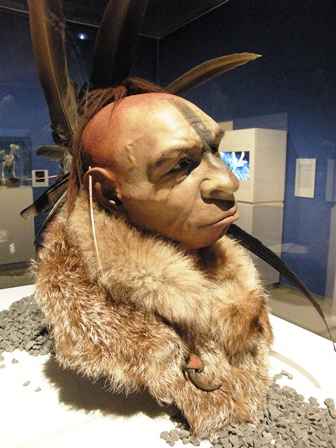
«humanos con una capacidad cognitiva muy próxima a la nuestra» mas que suficiente para tener pensamiento simbólico, y lenguaje, excelente articulo. Gracias!
Me gustaLe gusta a 2 personas
¿Se acabará llegando a la conclusión de que neanrdetales y «nosotros» somos en realidad los mismos?
Me gustaLe gusta a 1 persona
Mientras la genómica siga mostrando más separaciones que coincidencias, por ahora yo creo que no…
Me gustaLe gusta a 1 persona
Hi. Please check http://www.neanderthalsinplatoscave.com
The similarly titled book explores precisely the topic touched on in this blog.
Me gustaLe gusta a 1 persona
Excelente articulo! Desde Buenos Aires, Gustavo Candela
Me gustaLe gusta a 2 personas
Gracias Gustavo
Me gustaLe gusta a 1 persona
Great post thankkyou
Me gustaLe gusta a 2 personas
Una excelente entrada, Roberto Saez. Es apabullante lo que se va sabiendo de esta gente. Gracias por hacer la lista y suministrar los enlaces. He leído lo de las garras de águila de Krapina (¡la famosa Krapina! a ver si me informo más sobre su anterior fama) y aún estoy ojiplática… garras de pigargo europeo… no tiraban alto ni ná.
Me gustaLe gusta a 1 persona
Muchas gracias por tu comentario.
Me gustaMe gusta